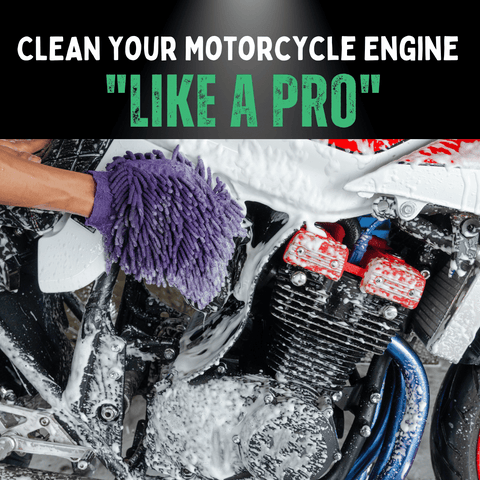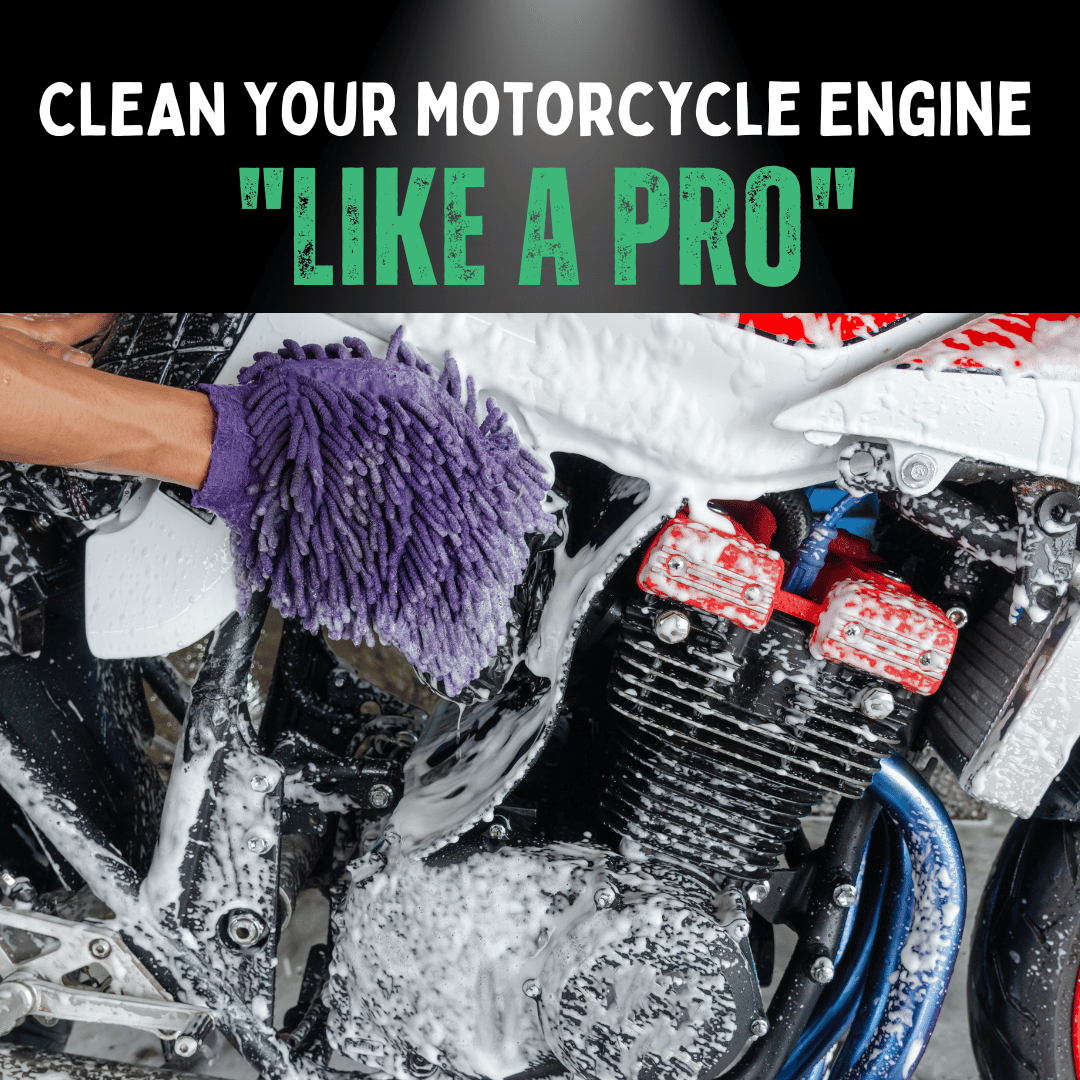
Published: 25.8.23
Updated: March 24, 2025
Your motorcycle is more than transportation—it’s your pride and joy, a symbol of freedom and adventure.
You’ve invested in your bike, and now it’s time to give its engine some TLC.
Wondering how to clean your motorcycle engine? You’re in the right place.
This 2025 guide offers 8 proven steps to clean your engine like a pro, enhancing both performance and appearance.
8 Proven Steps to Clean Your Motorcycle Engine Like a Pro
Gather supplies like a soft brush, air compressor, and degreaser. Prep the cooled engine, remove debris, degrease, scrub, rinse, dry, and polish for a spotless, high-performing engine.
Why Cleaning Your Motorcycle Engine Matters
Neglecting your engine is like ignoring a persistent cough—it affects performance.
Dirt, grease, and grime can build up, causing wear that regular cleaning prevents.
A clean engine runs better and looks great—ready for your next ride?
Inspirational Quote
"Clean Bike, Happy Life"
Steps to Clean Your Motorcycle Engine Like a Pro
1. Gather Necessary Supplies

Start with the right tools—don’t skip this step!
Check your manufacturer’s manual for specific tips, then gather:
- Microfiber Cloths: Scratch-free cleaning and drying.
- Soft-Bristled Brushes: Reach tight spots safely.
- Motorcycle Degreaser: Tackles grease and oil.
- Air Compressor: Blows away debris and dries.
- Protective Gear: Gloves and goggles for safety.
A solid toolkit sets you up for success.
Recommended Cleaning Supplies for UK Motorcyclists
| Item | Purpose | Additional Notes | Recommended UK Products |
|---|---|---|---|
| Motorcycle Cleaner | For effective and safe overall cleaning | Choose a pH-neutral formula safe for all surfaces | • Muc-Off Nano Tech Motorcycle Cleaner • XCP Motorcycle Cleaner • S100 Total Cycle Cleaner |
| Degreaser | To remove stubborn grease and oil stains | Select a motorcycle-specific product | • Muc-Off Motorcycle Degreaser • R&G Motorcycle Degreaser |
| Microfibre Cloths | For gentle cleaning and drying | Use separate cloths for cleaning and drying | • Muc-Off Premium Micro Fibre Cloth • Auto Finesse Duo Edgeless Cloths |
Download the full list: Recommended Cleaning Supplies
2. Prepare the Engine
Never clean a hot engine—let it cool completely first.
Cover sensitive areas like the air intake and electronics with plastic bags.
Related: Understanding Motorcycle CC
3. Remove Loose Debris
Use compressed air to blow off loose dirt before washing.
This prevents spreading muck around during cleaning.
4. Apply Degreaser
Spray a motorcycle-specific degreaser on grimy areas.
Let it sit for a few minutes to break down grease.
5. Scrub and Clean
Scrub with a soft brush, focusing on tight spots.
Keep going until all grime is gone—think of it as bike dental care!
Related: 25 Game-Changing Motorcycle Hacks
6. Rinse Thoroughly
Rinse with clean water to remove all degreaser and dirt.
Don’t skip this—leftover soap can attract more grime.
7. Dry and Polish
Dry with microfiber cloths to prevent water spots or rust.
Polish chrome or metal surfaces for a pro finish.
8. Clean Engine Fins
For finned engines, use a vinegar-water mix, scrub, and rinse.
This final touch keeps fins spotless.
Maintenance Tips for a Clean Engine

Keep your engine clean long-term with these tips:
- Check for leaks regularly.
- Use quality fuel to reduce buildup.
- Apply an engine treatment periodically.
Understanding Engine Dirt Types
Engines face dust, grease, oil, and carbon deposits.
Match your cleaner to the dirt—degreaser for grease, air for dust.
Safety Considerations
Wear gloves and goggles to shield against chemicals.
Work in a ventilated area and avoid smoking.
Related: How to Clean Dirt Bike Goggles
Seasonal Maintenance Tips
Adapt cleaning to the season:
- Summer: Clean cooling systems.
- Winter: Use rust protectant.
- Spring: Clear water-induced rust.
- Autumn: Remove leaf debris.
Related: How to Winterise Your Motorcycle
After-Care Tips
Lubricate moving parts lightly post-cleaning.
Monitor for leaks and consider a bike cover.
Top Engine Cleaning Products Reviewed
| Product | Pros | Cons | Best For |
|---|---|---|---|
| Muc-Off Motorcycle Degreaser | Highly effective, biodegradable formula | Relatively expensive | Tough grease and grime removal |
| S100 Total Cycle Cleaner | Versatile, easy to use, safe on all surfaces | May require agitation for tougher dirt | All-round cleaning, including engine |
| R&G Motorcycle Degreaser | Effective, good value for money | Strong smell | Engine degreasing, chain cleaning |
Common Mistakes to Avoid
- High-Pressure Water: Damages electronics—use a gentle stream.
- Hot Engine Cleaning: Risks residue—wait till it’s cool.
- Harsh Chemicals: Harms finishes—stick to bike-specific products.
- Skipping Rinse: Leaves residue—rinse thoroughly.
Eco-Friendly Engine Cleaning Tips
1. Use Biodegradable Cleaners
Opt for eco-friendly products like Muc-Off Nano Tech Bike Cleaner.
2. Conserve Water
Use a bucket or spray bottle instead of a hose.
3. Proper Disposal
Avoid storm drains—collect waste for recycling centers.
Conclusion
Your motorcycle engine deserves top care for peak performance.
With these 8 steps, you’ll clean like a pro and hit the road with pride.
FAQs
Is Disassembling the Engine Necessary?
No—avoid it unless fixing a specific issue, as it may disrupt wear fit.
Can I Use Household Cleaners?
Avoid them—harsh chemicals can damage bike parts. Use motorcycle cleaners.
Is Pressure Washing Safe?
Use caution—protect electronics and use low pressure near the engine.
How Do I Maintain Engine Cleanliness?
Apply a protectant and do regular quick clean-ups.
Ready to Ride? 🚀
Loved this guide on cleaning your motorcycle engine? Explore more tips!
Questions about kids’ ride-on toys? Visit RiiRoo.com.








Share:
25 GAME-CHANGING Motorcycle Hacks You NEED to Know
10 CRUCIAL Facts About Motorcycle Helmets YOU Need to Know